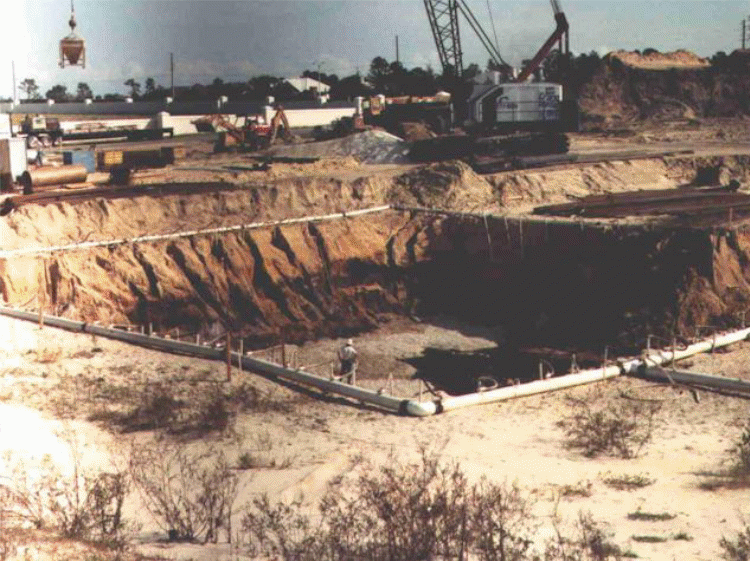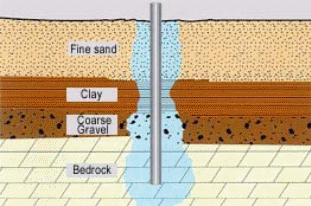Introduction
The essay is a critical examination of advantages and disadvantages of dewatering techniques. The various techniques analyzed in the essay are general sump pumping, open dewatering, well points, deep well and submersible, ground freezing and electro osmosis. Dewatering typically refers to the act of removing water from solid materials or even soils. This is done mainly by “classification, centrifugation, filtration or similar solid-liquid separation processes” (Turovskiĭ & Mathai, 2006). In construction, it refers to removing or draining water either found under the ground or on earth surface from place of construction, river beds or mine shafts among other related works. All the mentioned techniques of dewatering do have advantages as well as disadvantages.
General sump pumping
Generally speaking sump pumping has been used by individuals to remove water from their houses or compounds. The pumps are less noisy; for instance submersible sump pump have been shown to be quieter when under operation. Additionally, there is a provision in which it turns on automatically provided that water has reached a certain level. On the same note, the way the pumps have been build ensures that when there is need for repairing then it does not require a lot of labor and also it is less expensive. The automation mechanism makes the technique more reliable.
The method works well in tight and soils having a fine grain as well as course and boulder deposits. However, the problem with this technique is that it only pumps water that is not solid. Another draw back of using general sump pumping technique is that the amount of water removed entirely depends on how reliable is the pump as well as the supply of power. This can be a problem when the later is in short supply. Sump dewatering is also characterized by backfilling that hinders construction works as it compromises the sub-grade substrate.
Open dewatering
As suggested by Powers, 1992 it is applicable in situations where one wishes to bring down level of groundwater table where the soils are cohesive and have lower permeability. The technique can be temporary installed, work well in toughest environment especially when gravel, sand and other particles are present. It also works well in greater depths. Similarly, it has been noted that open dewatering is the simplest methods of dewatering since it entails placing of a suction hose and the water is then removed. It takes little space and due to the ability to temporary installs them and being easy to remove it can serve several areas or locations. The major limitation of this method is the lack of ability to be used in hard strata. Similarly construction work cannot go on till the ground is completely dry and stable.
Well points
The technique helps control level of water in an aquifer. The advantage of this technique rests mostly in its ability to cut cost. Additionally it is suitable for removing water from shallow excavations approximately 6.5 m in soils that are stratified (Powers, 1992). This can also be seen as a disadvantage especially when the excavations are deep than 7.0 m. However, the provision of installing it in stages can address this problem. Additionally the ability of the technique to perform better in a wide range of soils is an advantage. Well points also make it possible to have “a much thicker width free from seepage forces” (Turovskiĭ & Mathai, 2006). One major disadvantage of this technique is that it is somewhat expensive when compared to sump pumping method.

Deep well and submersible
Using this technique to remove water has been shown to be effective as well as having a higher capacity. It is suitable in water that has no particles. Additionally the maintenance of the equipment used is chap and easy. Finally it works well in deep wells > 80fts or more. The major limitations or drawbacks of this technique are; impellers as well as diffuser cannot stand the presence of particles for instance sand (Powers, 1992). Similarly, when the water being removed contains gases it may lock the pump and finally the pump can malfunction if the well runs dry.
Ground freezing
According to Harris, 1995 the technique uses heat transfer to stabilize the ground; soil water is turned into ice. The advantages include; can be applied in any type of soils as well as varying groundwater conditions, has no known long term consequences on subsurface environment. Additionally, the technique can be easily and completely removed, suitable in controlling water movement from one region to another only in temporal basis and it can completely cut of water. Lastly it is the most effective method in situations where other techniques such as pumping cannot be attained. The ability to completely cut off water makes it possible for work to continue without worrying about seepage. One major disadvantage of this technique is that it uses a lot of energy in trying to maintain the frozen condition.

Electro osmosis
Unlike mechanical dewatering techniques, electro osmosis dewatering has several advantages which include; it can successfully remove water from sludge characterized by very fine particles as well as materials deemed to be gelatinous. The method is also very economical since it utilizes minimal power and yield tremendous results. In areas where the water being removed contains pathogens and bad smell, then the technique can help come up with high quality biomass (Yoshida, 1993). Similarly the equipment used in the process of dewatering is easy to use and maintain. Although it has the mentioned advantages, the technique cannot completely remove water in sludge since a discontinuous of a liquid state cut electric flow hence stopping electro-osmosis process.
References
Harris, J. (1995). Ground Freezing in Practice. London: Thomas Telford Services Ltd.
Powers, J. (1992). Construction dewatering: new methods and applications. New York City: John Wiley & Sons.
Turovskiĭ, I. & Mathai, P. (2006). Dewatering: Wastewater sludge processing. Hoboken, New Jersey: John Wiley & Sons.
Yoshida, H. (1993). “Practical aspects of dewatering enhanced by electro-osmosis: Drying Technology” An International Journal, 11(4): 784-814.